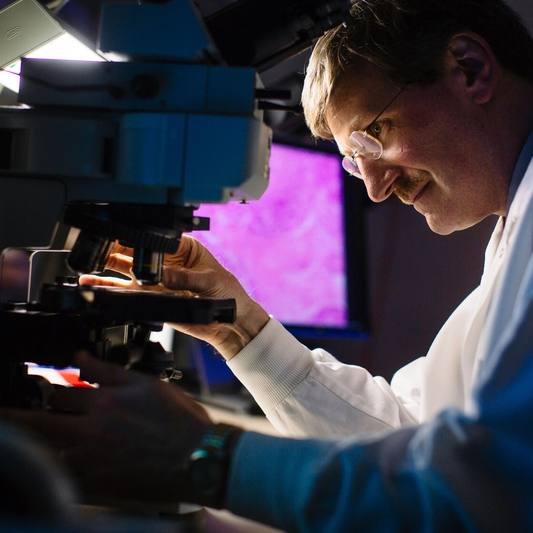-
Research
To Beat 1 of the Biggest Killers, Scientists Think Small
With a five-year survival rate of less than 5%, a type of pancreatic cancer called pancreatic ductal adenocarcinoma is an urgent research priority. Now a team of Mayo Clinic scientists, with collaborators from the Karolinska Institute in Sweden, have developed a new, multidrug nanoformulation — a combination of two drugs delivered directly to tumor cells via a specific type of nanoparticle — shown to have potential for treating this disease in mice. Their findings appear in a new paper in the journal Nanoscale.
"While our data are preliminary, we observed remarkable anti-tumor efficacy," says Debabrata Mukhopadhyay, Ph.D., a cancer and nanomedicine specialist at Mayo Clinic in Florida and senior author of the paper.

Nanotechnology is an emerging field of research that studies materials the size of an atom. Many materials change their properties at the atomic level, making nanoparticles potentially useful in delivering therapeutic drugs to cells, and helping diagnose, treat and monitor diseases from within.
In the field of cancer nanomedicine, scientists are learning how to deliver tiny amounts of anti-cancer drugs directly to tumor cells. In contrast to traditional drug delivery modes, nanoparticles can be targeted to destroy tumor cells directly without affecting healthy tissues, resulting in minimal side effects for cancer patients.
In their current work, the investigators used nanodiamonds — a type of nanoparticle with properties particularly useful for drug delivery — to assess whether a combination of two existing drugs could effectively kill pancreatic cancer cells in clinically relevant mouse models. Compared to mice treated with a single drug, the researchers found that the drug combination was capable of producing pronounced anti-tumor effects. They also showed that nanodiamond delivery could target tumors with precision.
This finding builds on results published earlier this year, in which this team demonstrated that it is possible to attach pancreatic cancer drugs to nanodiamonds.
"Our work is still in early stages. Further, rigorous validation studies are needed to take it from bench to bedside," says Vijay Madamsetty, Ph.D., the study's first author. Future research may explore how to use nanodiamonds to reach cancer cells even more precisely, which other drug combinations are able to be attached to a nanodiamond platform, and additional cancer types for which nanodiamond drug delivery may be indicated.
"Our eventual hope is that this new method may be used to develop precision treatments for pancreatic cancer patients with minimal side effects," says Dr. Madamsetty.
The study was funded by the National Institutes of Health, the Florida Department of Health, and the Swedish Cancer Foundation.







